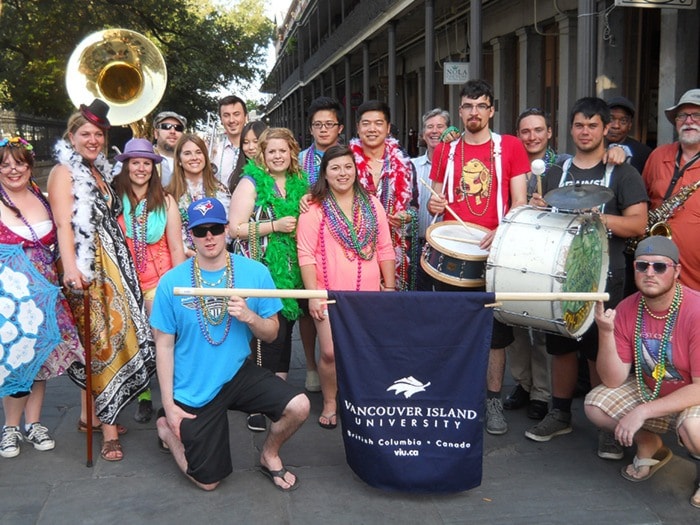By Marilyn Assaf
When Jon Bauer moved to Nanaimo, B.C. from Fort McMurray, Alta. to study music, he never dreamed the journey would lead him all the way to New Orleans.
Bauer was among 17 Vancouver Island University students who recently participated in a two-week field school called Finding Community, New Orleans-style.
The interdisciplinary field school, led by faculty members Stephen Burr, hospitality management; Steve Jones, music studies; and Tom Delamere, recreation and tourism management, immersed students in the meaning of community through music, food, culture, customs, and examined how New Orleans has rebuilt after Hurricane Katrina.
“Students discovered the community of New Orleans is unique,” said Burr. “Beauty and decay, excess and conservatism – these dichotomies have always existed in New Orleans and have been sharply underscored since the flood.”
Students witnessed the disparity of poverty, substandard housing, inferior education and gun violence among the African-American population. They also had the opportunity to see that same community rally with grassroots organizations that are determined to rebuild their homes and families, and continue to honour their culture, music and customs.
According to Burr, 80 per cent of the New Orleans population is native-born, and customs are multi-generational and deeply ingrained.
“This field school was an eye-opening experience,” said Bauer, who begins his fourth year of VIU’s bachelor of music in jazz studies next September. “I learned more than if I had gone to New Orleans on my own. We participated in some amazing activities that immersed us in the local culture. This has given me memories I will never forget.”
New Orleans is a proud city, and its culture is embedded in the people, added Bauer.
“Though they may be faced time and time again with natural disaster, the community feeling of New Orleans only grows stronger,” he said. “The community made us feel so welcome that many of us didn’t want to leave.”
The group spent a day at Jazz Fest, which set the tone for the field school, as New Orleans is all about music – on the streets and in the clubs. Bauer says a major highlight was participating in a parade in an area known as the French Quarter, led by Dave Hansen, VIU alumnus and current New Orleans resident and musician.
“We were dancing and playing instruments with some of New Orleans’ finest musicians. The parade is a huge deal in New Orleans and a big part of the culture. You can often find musicians going down Bourbon Street, in the heart of one of New Orleans’ oldest neighborhoods. As our group paraded around the corner, the entire community around us joined in. People came to dance, and sing, and take pictures. It was great,” said Hansen.
Other highlights included a visit to the Golden Feather restaurant beside Congo Square, where Mardi Gras Indian chief Shaka Zulu explained the importance of the Mardi Gras Indian culture, and their ‘suits.’ Each suit takes a year to create, with hand-sewn beads and feathers, weighs 45 kilograms, can cost $5,000 or more and are worn just once.
The group also participated in guided tours of Algiers Point, a historical settlement across the Mississippi River from New Orleans, accessed by foot ferry; tours of Laura Plantation, an intact Creole sugar cane plantation and tours of the Old U.S. Mint, home to the New Orleans Jazz Club collection.
Students also spent two days volunteering with an organization called Rebuilding Together, cleaning up tainted drywall residue on a home in the Lower Ninth Ward. “It was very hard, hot work, but many students considered this a highlight, as they met the owner of the home,” said Burr.
Food is also an important part of what creates a community. During the field school, students tried gumbo, jambalaya, alligator, po-boys, local seafood, beignets, muffalettas, and may have tried a local Abita beer or two.
“It was a great learning experience and the students enthusiastically engaged in a full itinerary, and created their own community,” said Burr.
For Bauer, memories of New Orleans and its music will never be far from his mind.
“I can’t wait to go back,” he said.
